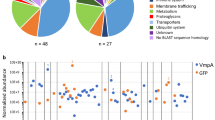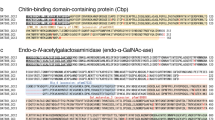Abstract
AN apparent nuclear disease of the larva of the crane fly, Tipula paludosa, was briefly described in 1923 by Rennie1. We have now rediscovered this disease, which seems to be infectious, and have compared it to some extent with the nuclear and cytoplasmic polyhedroses of lepidopterous larvæ, from which it differs in some important respects.
This is a preview of subscription content, access via your institution
Access options
Subscribe to this journal
Receive 51 print issues and online access
$199.00 per year
only $3.90 per issue
Buy this article
- Purchase on Springer Link
- Instant access to full article PDF
Prices may be subject to local taxes which are calculated during checkout
Similar content being viewed by others
References
Rennie, J., Proc. Roy. Phys. Soc., Edin., 20, 265 (1923).
Smith, Kenneth M., and Xeros, N., Nature, 172, 670 (1953).
Smith, Kenneth M., and Wyckoff, R. W. G., Nature, 166, 861 (1950).
Smith, Kenneth M., and Xeros, N., Parasitology (in the press).
Author information
Authors and Affiliations
Rights and permissions
About this article
Cite this article
SMITH, K., XEROS, N. An Unusual Virus Disease of a Dipterous Larva. Nature 173, 866–867 (1954). https://doi.org/10.1038/173866a0
Issue Date:
DOI: https://doi.org/10.1038/173866a0
This article is cited by
-
Atomic structure of a nudivirus occlusion body protein determined from a 70-year-old crystal sample
Nature Communications (2023)
-
Dissolution des Inclusions du Virus de la Polyédrose Nucléaire du DiptèreTipula paludosa MEIG. Etude Ultrastructurale du Virion
Archives of Virology (1977)
-
Intranuclear Changes in the Polyhedrosis of Tipula paludosa (Diptera)
Nature (1955)
-
A Second Virus Disease of the Leatherjacket, Tipula paludosa
Nature (1954)
Comments
By submitting a comment you agree to abide by our Terms and Community Guidelines. If you find something abusive or that does not comply with our terms or guidelines please flag it as inappropriate.



